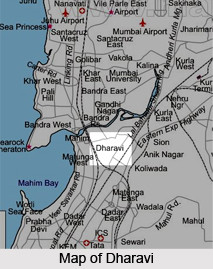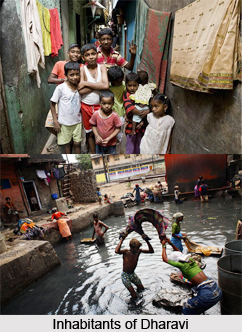 Dharavi is a locality in Mumbai, Maharashtra. It has been described as Asia"s largest slum and is a heart shaped settlement. Dharavi slum was founded in 1882 during the British colonial era. The slum grew in part because of an expulsion of factories and residents from the peninsular city centre by the colonial government and from rural poor migrating into urban Mumbai. It is currently a multi-religious, multi-ethnic, diverse settlement.
Dharavi is a locality in Mumbai, Maharashtra. It has been described as Asia"s largest slum and is a heart shaped settlement. Dharavi slum was founded in 1882 during the British colonial era. The slum grew in part because of an expulsion of factories and residents from the peninsular city centre by the colonial government and from rural poor migrating into urban Mumbai. It is currently a multi-religious, multi-ethnic, diverse settlement.
Location of Dharavi
Dharavi is a large area located between Mumbai"s two main suburban railway lines, the Western and Central Railways. To its west are Mahim and Bandra, and to the north lies the Mithi River, which empties into the Arabian Sea through the Mahim Creek. To its south and east are Sion and Matunga.
Demography of Dharavi
 The total current population of Dharavi slum is unknown, and estimates vary widely. Some sources suggest it is 300,000 to about a million. With Dharavi spread over 200 hectares, this corresponds to an average population density estimate between 1500 and 5000 i.e. 600 to 2,000 people per acre.
The total current population of Dharavi slum is unknown, and estimates vary widely. Some sources suggest it is 300,000 to about a million. With Dharavi spread over 200 hectares, this corresponds to an average population density estimate between 1500 and 5000 i.e. 600 to 2,000 people per acre.
Inhabitants of Dharavi
Initially, Dharavi was one of the 6 great "Koliwadas of Bombay" - one of the city"s vast fishing communities. The Koli tribe was the fisher folk who lived at the edge of the creek that came in from the Arabian Sea. Sion had a dam adjacent to Dharavi that quickened the process of joining separate islands into one long tapered mass. The creek dried up and the fisher folk were deprived of their livelihood, but the newly drained marshes provided space for new communities to move in. The migrants could be roughly divided into two broad categories.
The first were people from Maharashtra, and in particular from the Konkan coast, as well from Gujarat. The Kumbhars came from Gujarat to establish a potter"s colony called "Kumbharwada". The other settlers were direct migrants to the city, many of them trained in a trade or a craft. Muslim tanners from Tamil Nadu migrated to Dharavi and set up the leather tanning industry. Thousands travelled from Uttar Pradesh to work in the textile industry. Some were the embroidery workers who started the ready-made garments trade. From Tamil Nadu, workers joined the flourishing business of making sweets and various other snacks.
Sanitation Issues of Dharavi
Dharavi has severe problems with public health. Water access derives from public standpipes stationed throughout the slum. Additionally, with the limited lavatories they have, they are extremely filthy and broken down to the point of being unsafe. Mahim Creek is a local river that is widely used by local residents for urination and defecation causing the spread of contagious diseases. The open sewers in the city drain to the creek causing a spike in water pollutants, septic conditions and foul odours. Due to the air pollutants, terrible diseases such as lung cancer, tuberculosis, and asthma are common among residents. There are government proposals in regards to improveDharavi"s sanitation issues.
Epidemics and Disasters in Dharavi
Dharavi has experienced a long history of epidemics and natural disasters, sometimes with significant loss of lives. Dysentery epidemics have been common throughout the years and explained by the high population density of Dharavi. Other epidemics reported include typhoid, cholera, leprosy, amoebiasis and polio, through recent years. In recent years, cases of drug resistant tuberculosis have been reported in Dharavi.
Fires and other disasters are common. For example, in January 2013, a fire destroyed many slum properties and caused injuries. In 2005, massive floods caused deaths and extensive property damage.



















